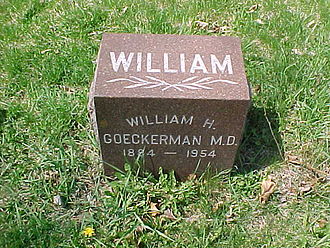Goeckerman therapy
Goeckerman Therapy[edit]

Goeckerman therapy is a treatment regimen for psoriasis that combines the application of crude coal tar with exposure to ultraviolet light. This therapy was developed in the 1920s by William H. Goeckerman, a dermatologist at the Mayo Clinic.
History[edit]
Goeckerman therapy was first introduced by Dr. William H. Goeckerman in 1925. At the time, psoriasis was a challenging condition to treat, and Dr. Goeckerman's method provided a significant improvement in patient outcomes. The therapy was based on the observation that coal tar had been used for centuries to treat skin conditions, and ultraviolet light was known to have beneficial effects on psoriasis.
Mechanism of Action[edit]
The effectiveness of Goeckerman therapy is attributed to the synergistic effects of coal tar and ultraviolet light. Coal tar is believed to have anti-inflammatory and antiproliferative properties, which help to slow down the rapid growth of skin cells seen in psoriasis. Ultraviolet light, particularly UVB, further aids in reducing inflammation and scaling.
Procedure[edit]
The Goeckerman regimen typically involves the daily application of crude coal tar to the affected areas of the skin, followed by exposure to UVB light. The treatment is usually conducted in a clinical setting, although home-based regimens have also been developed. The duration of the therapy can vary, but it often lasts for several weeks.
Efficacy[edit]
Goeckerman therapy has been shown to be highly effective in clearing psoriasis lesions. Many patients experience significant improvement or complete remission of their symptoms. However, the therapy requires a considerable time commitment and can be messy due to the nature of coal tar.
Side Effects[edit]
Common side effects of Goeckerman therapy include skin irritation, folliculitis, and a strong odor from the coal tar. Long-term use of coal tar has raised concerns about potential carcinogenicity, although studies have not conclusively demonstrated an increased risk of cancer with Goeckerman therapy.
Modern Use[edit]
While newer treatments for psoriasis, such as biologics, have become available, Goeckerman therapy remains a valuable option, particularly for patients who do not respond to other treatments or prefer a non-systemic approach. It is often used in specialized dermatology centers.
Related Pages[edit]
Ad. Transform your life with W8MD's Budget GLP-1 injections from $75


W8MD offers a medical weight loss program to lose weight in Philadelphia. Our physician-supervised medical weight loss provides:
- Weight loss injections in NYC (generic and brand names):
- Zepbound / Mounjaro, Wegovy / Ozempic, Saxenda
- Most insurances accepted or discounted self-pay rates. We will obtain insurance prior authorizations if needed.
- Generic GLP1 weight loss injections from $75 for the starting dose.
- Also offer prescription weight loss medications including Phentermine, Qsymia, Diethylpropion, Contrave etc.
NYC weight loss doctor appointmentsNYC weight loss doctor appointments
Start your NYC weight loss journey today at our NYC medical weight loss and Philadelphia medical weight loss clinics.
- Call 718-946-5500 to lose weight in NYC or for medical weight loss in Philadelphia 215-676-2334.
- Tags:NYC medical weight loss, Philadelphia lose weight Zepbound NYC, Budget GLP1 weight loss injections, Wegovy Philadelphia, Wegovy NYC, Philadelphia medical weight loss, Brookly weight loss and Wegovy NYC
|
WikiMD's Wellness Encyclopedia |
| Let Food Be Thy Medicine Medicine Thy Food - Hippocrates |
Medical Disclaimer: WikiMD is not a substitute for professional medical advice. The information on WikiMD is provided as an information resource only, may be incorrect, outdated or misleading, and is not to be used or relied on for any diagnostic or treatment purposes. Please consult your health care provider before making any healthcare decisions or for guidance about a specific medical condition. WikiMD expressly disclaims responsibility, and shall have no liability, for any damages, loss, injury, or liability whatsoever suffered as a result of your reliance on the information contained in this site. By visiting this site you agree to the foregoing terms and conditions, which may from time to time be changed or supplemented by WikiMD. If you do not agree to the foregoing terms and conditions, you should not enter or use this site. See full disclaimer.
Credits:Most images are courtesy of Wikimedia commons, and templates, categories Wikipedia, licensed under CC BY SA or similar.
Translate this page: - East Asian
中文,
日本,
한국어,
South Asian
हिन्दी,
தமிழ்,
తెలుగు,
Urdu,
ಕನ್ನಡ,
Southeast Asian
Indonesian,
Vietnamese,
Thai,
မြန်မာဘာသာ,
বাংলা
European
español,
Deutsch,
français,
Greek,
português do Brasil,
polski,
română,
русский,
Nederlands,
norsk,
svenska,
suomi,
Italian
Middle Eastern & African
عربى,
Turkish,
Persian,
Hebrew,
Afrikaans,
isiZulu,
Kiswahili,
Other
Bulgarian,
Hungarian,
Czech,
Swedish,
മലയാളം,
मराठी,
ਪੰਜਾਬੀ,
ગુજરાતી,
Portuguese,
Ukrainian